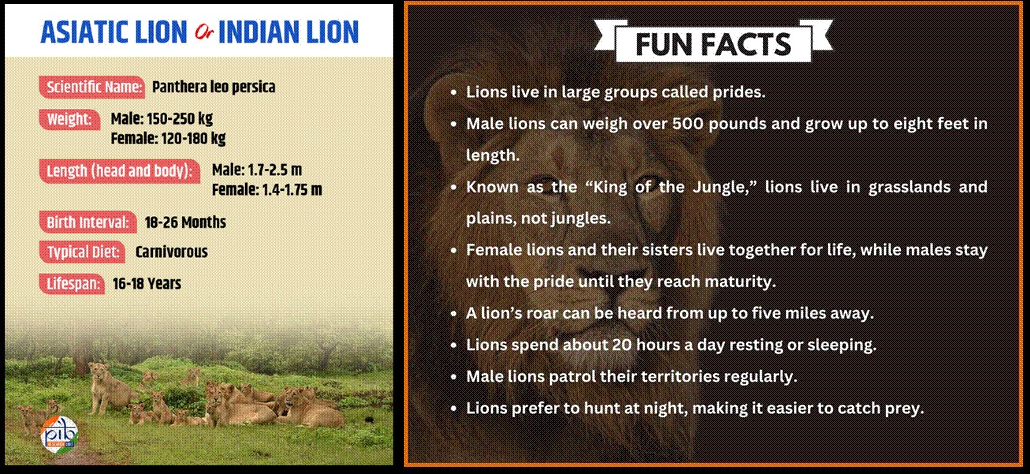Important Facts For Prelims
16th Asiatic Lion Census 2025
- 22 May 2025
- 5 min read
Why in News?
Asiatic lion (Panthera leo persica) population in Gujarat goes up from 674 to 891 in 5 years, according to the 16th census 2025 released by the Gujarat Forest Department.
What are the Key Findings of 16th Asiatic Lion Census 2025?
- Total Population: 891 Asiatic lions recorded in Gujarat, a 32.2% increase from 674 lions in 2020 (15th census).
- Population Distribution: 384 lions live inside protected forest and sanctuary areas. Lions in non-forested areas have risen from 340 in 2020 to 507 in 2025.
- 44.22% of the lion population now resides outside traditional protected habitats.
- Gir National Park and adjoining sanctuaries (Gir Wildlife Sanctuary, and Pania Wildlife Sanctuary) house 394 lions, forming the core population.
- Amreli district has the highest count with 257 lions, while Mityala Wildlife Sanctuary doubled its population to 32 lions.
- Barda Wildlife Sanctuary near Porbandar has become a newly established lion population area, with 17 lions recorded, the first since 1879.
- The 2025 census also identified new satellite populations around Jetpur and Babra-Jasdan.
- Adult Females: 330 adult females recorded, a 27% rise since 2020, indicating strong potential for further growth.
- Reasons of Population Boom: Project Lion has helped in restoring habitats, strengthening the prey base, and mitigating conflicts to support Asiatic lion conservation.
- Census methodology: Conducted using direct beat verification (the area was divided into regions, zones, and sub-zones with designated officials, enumerators, supervisors, and volunteers), a more scientific and statistically robust method compared to pugmark-based tiger surveys.
- Completed in just three days, unlike the tiger census which takes two years.
What is Project Lion?
- Project Lion: Announced in 2020, Project Lion is a long-term initiative aimed at securing the future of Asiatic lions by creating a sustainable environment that enhances the overall health of their ecosystems.
- The project, being implemented in the Gir landscape in Gujarat, focuses on habitat improvement, the use of advanced technologies such as radio-collaring and camera traps for monitoring, and the mitigation of human-wildlife conflict.
- The Gujarat Forest Department plays a central role in implementing these conservation measures, conducting regular lion censuses to track population trends and health.
- Technologies in Lion Conservation: Advanced tools such as Global Positioning System-based tracking are used to monitor lions and vehicles, ensuring efficient surveillance.
- An automated sensor grid, which includes magnetic, movement, and infrared heat sensors, helps detect and track wildlife activity.
- Geographic Information System (GIS)-based real-time monitoring enables timely analysis, report generation, and effective management of conservation efforts.
Note: The International Union for Conservation of Nature (IUCN) released the first Green Status Assessment for lions in 2025, providing a global standard to measure species recovery and conservation impact.
- IUCN Green Status of Species covers all species except microorganisms and uses eight categories (Extinct in the Wild, Critically Depleted, Largely Depleted, Moderately Depleted, Slightly Depleted, Fully Recovered, Non-Depleted and Indeterminate).
- Unlike the IUCN Red List, which focuses on extinction risk, the Green Status highlights recovery potential and necessary conservation actions. Lions have been placed in the Largely Depleted category.
UPSC Civil Services Examination Previous Year Question (PYQ)
Prelims
Q. Consider the following statements: (2019)
- Asiatic lion is naturally found in India only.
- Double-humped camel is naturally found in India only.
- One-horned rhinoceros is naturally found in India only.
Which of the statements given above is/are correct?
(a) 1 only
(b) 2 only
(c) 1 and 3 only
(d) 1, 2 and 3
Ans: (a)








